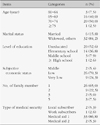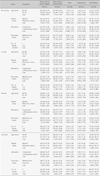Abstract
Purpose
The purpose of this study was to analyze the effects of a case management program on range of motion, pain, depression and self efficacy in community-dwelling older women with knee arthritis.
Methods
The research design was one-group pre and post-test design with 40 participants with knee arthritis who agreed to participate in the 12-week case management program. Data were collected four times, before and after 4, 8 and 12 weeks.
Results
Repeated measures ANOVA revealed significant differences between before and after the service in range of motion, pain, depression and self efficacy. Significant improvements from the baseline to 4 weeks after the service were observed in the measurements of range of motion, pain, depression and self efficacy. There were no significant differences in range of motion, pain and depression between 4 and 12 weeks after the services.
Conclusion
This study represents the first effort showing that a case management program can have positive outcomes on range of motion, pain, depression and self efficacy for older women with knee arthritis. More research using a control group pre-post test design considering time lapse is needed in order to examine more accurately the effects of case management programs for knee arthritis.
Figures and Tables
References
1. An JY, Tak YR. Depressing symptoms and related risk factors in old and oldest-old elderly people with arthritis. J Korean Acad Nurs. 2009; 39(1):72–83.
2. Barry J, McQuade C, Livingstone T. Using nurse case management to promote self-efficacy in individuals with rheumatoid arthritis. Rehabil Nurs. 1998; 23(6):300–304.

3. Bellamy N. Musculoskeletal clinical metrology. London: Kluwer Academic Publishers;1993.
4. Bernabei R, Landi F, Gambassi G, Sgadari A, Zuccala G, Mor V, et al. Randomised trial of impact of model of integrated care and case management for older people living in the community. BMJ. 1998; 316(7141):1348–1351.

5. Cheon EY. The effects of a self-management program on physical function and quality of life of patients with knee osteoarthritis. J Korean Acad Nurs. 2005; 35(3):514–525.

6. Cohen J. Statistical power analysis for the behavioral sciences. 2nd ed. New Jersey: Lawrence Erlbaum Associates;1988.
7. Fitzgerald JF, Smith DM, Martin DK, Freedman JA, Katz BP. A case manager intervention to reduce readmissions. Arch Intern Med. 1994; 154(15):1721–1729.

8. Jeong YH, Ko SJ. Studies on the lifetime medical expenditure (1). Seoul: Korea Institute for Health and Social Affairs;2009.
9. June KJ, Lee JY, Yoon JL. Effects of case management using resident assessment instrument-home care (RAI-HC) in home health services for older people. J Korean Acad Nurs. 2009; 39(3):366–375.

10. Kee BS. A preliminary study for the standardization of geriatric depression scale short form-Korea version. J Korean Neuropsychiatr Assoc. 1996; 35:298–307.
11. Kim HS, Kim YS. A study on the quality of life, self-efficacy and family support of stroke patients in oriental medicine hospitals. J Korean Soc Health Educ Promot. 2003; 20(1):111–130.
12. Kim I, Suh MJ. The related factors of self-efficacy in patients with rheumatoid arthritis. J Korean Acad Adult Nurs. 1999; 11(1):87–95.
13. Korea National Statistical Office. 2010 elderly statistics. 2010. Retrieved March, 10, 2011. from http://kosis.kr/wnsearch/totalSearch.jsp.
14. Lee EO, Suh MJ, Kim IJ, Kang HS, Kim MS, Kim YJ, et al. The relationship among self-efficacy, pain, depression, and ADL in chronic arthritis. J Rheumatol Health. 1996; 3(2):194–208.
15. Lee HY. Comparison of effects among tai-chi exercise, aquatic exercise, and a self-help program for patients with knee osteoarthritis. J Korean Acad Nurs. 2006; 36(3):571–580.

16. Lee HY, Lee KJ. Effects of tai chi exercise in elderly with knee osteoarthritis. J Korean Acad Nurs. 2008; 38(1):11–18.

17. Lee SH, Yang SO. The effects of chronic musculoskeletal pain and depression on health-related quality of life by gender in community-dwelling older adults. J Korean Acad Community Health Nurs. 2010; 21(1):21–30.

18. Ministry of Health and Welfare. Handbook of customized home visiting health service. Seoul: Ministry of Health and Welfare;2007.
19. Ministry of Health and Welfare. Guideline for customized home visiting health service. Seoul: Ministry of Health and Welfare;2010.
20. Ministry for Health, Welfare and Family Affairs. Case management focusing on the joint pain. Seoul: Ministry for Health, Welfare and Family Affairs;2008.
21. National Health Insurance Corporation. 2010 health insurance statistical analysis data book. Seoul: National Health Insurance Corporation;2010.
22. Park JS, Kwon SJ, Kwon YS. The Effects of Dogbi(ST35) & Sulan Moxibustion on Knee Joint Pain, Range of Motion and Discomfort during ADL in the Aged. J Korean Acad Nurs. 2006; 36(1):189–196.
23. Park MH, Ha JC, Shin IH, Kim HG, Lee SY, Cho JH, et al. 2008 living profiles and welfare services needs of older persons in Korea. Seoul: Korea Institute for Health and Social Affairs Publishing;2009.
24. Riegel B, Carlson B, Kopp Z, LePetri B, Glaser D, Unger A. Effect of a standardized nurse casemanagement telephone intervention on resource use in patients with chronic heart failure. Arch Intern Med. 2002; 162(6):705–712.

25. Rosemann T, Joos S, Laux G, Gensichen J, Szecsenyi J. Case management of arthritis patients in primary care: A cluster-randomized controlled trial. Arthritis Rheum. 2007; 57(8):1390–1397.

26. Sheikh JI, Yesavage JA. Geriatric depression scale (GDS): Recent evidence and development of a shorter version. In : Brink TL, editor. Clinical Gerontology: A guide to assessment and intervention. New York: The Harwoth Press;1986. p. 165–173.
27. Sherer M, Maddux JE. The self efficacy scale:Construction & validation. Psychol Rep. 1982; 51:663–671.
28. Yang JH. The effects of hand acupuncture therapy on pain, ROM, ADL and depression among elders with low back pain and knee joint pain. J Korean Acad Nurs. 2009; 39(1):10–20.

29. Yang SO, Ahn SY, Yim ES, Kwon MS. The effects of customized home visiting health service in Gangwon-do. J Korean Acad Community Health Nurs. 2008; 19(1):88–100.




 PDF
PDF ePub
ePub Citation
Citation Print
Print









 XML Download
XML Download